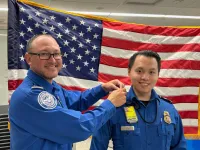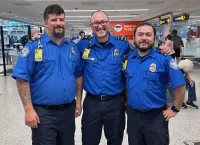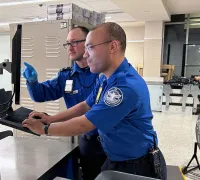 LTSO Cade Hammerschmidt coaches officer-in-training Sreekala Kulasekhsar on the X-ray. (Sarah Covington photo)
LTSO Cade Hammerschmidt coaches officer-in-training Sreekala Kulasekhsar on the X-ray. (Sarah Covington photo)
In 2008, Cade Hammerschmidt joined TSA to open a career path to the U.S. Fish and Wildlife Service, but even with a degree in environmental studies, it didn’t take him long to realize TSA was the right place for him.
It’s in Hammerschmidt’s DNA to coach others, and he quickly took that passion to a high level at Minneapolis–Saint Paul International Airport (MSP). For the last 14 years, he has been a checkpoint lead transportation security officer (LTSO) with his big focus on teaching and coaching new screeners.
“I have been coaching or training in some capacity for a large portion of my life,” said Hammerschmidt. “I have coached different sports and been involved with training in past careers. My mother was a teacher for over 30 years, and I feel I received my desire to educate and help others from her.”
Early in his TSA career, Hammerschmidt served on MSP’s detection enhancement team, and that’s when he realized he preferred one-on-one training at the checkpoint, leading him to his decision to become an on-the-job (OJT) coach.
Hammerschmidt has served as a coach and mentor for most of his 16 years at TSA and is currently one of the LTSOs on the a.m. shift training team. He coaches new officers on all aspects of daily checkpoint operations.
“As an OJT coach, your responsibilities are to train officers on all aspects of checkpoint operations,” he explained. “This begins with Phase 1 training before new hires go to the TSA Academy, which includes standard divestiture, divestiture at the X-ray, automated screening lanes, travel document checker, walk-through metal detector and exit lanes. After graduating from the Academy, Phase 2 training includes X-ray, property search, pat-downs including passengers with disabilities, bottled liquid scanner and general explosives trace detection procedures.”
Hammerschmidt approaches each new TSA officer as a unique experience.
“Everyone learns differently, and you have to approach coaching that way,” he emphasized. “You have to find the most effective way to coach each person.”
As an LTSO, Hammerschmidt spends a vast majority of his time devoted to OJT coaching, which he considers to be crucial in the develop of new screeners.
“Coaching is so important, because we are developing the future officers, leaders, trainers, mentors and coaches at TSA,” he said. “We are helping to create and strengthen our dynamic workforce. These are the people who will be keeping the traveling public safe daily.”
When asked how he would compare coaching and mentoring, Hammerschmidt said the two are interchangeable, and he’s not only cultivating new officers.
“Mentoring is how I began teaching people at TSA,” said the 14-year LTSO. “Officers who showed interest in becoming a lead would shadow me during a normal workday. Then, after a promotion, they would work directly with me to learn the LTSO duties and responsibilities.”
While coaching a new officer, Hammerschmidt is required to document all on-the-job training and fill out daily paperwork, rating the new hire’s progression on a scale from 1 to 5. He believes his work and the work of other OJT coaches have a direct impact on airport security operations.
“Coaching directly impacts security operations by being a conduit for maintaining proper staffing levels,” he noted.
Hammerschmidt admits OJT coaching comes with its fair share of challenges.
“The biggest challenges for an OJT coach day-to-day involve the ability to convey important information in a manner the trainee will understand and put into practice. We also have the challenge of not slowing down security operations while training. Some of the challenges new officers face are figuring out how to handle stressful situations with passengers and how to deescalate these occurrences.”
However, Hammerschmidt has had the privilege of coaching countless exceptional officers over the years, many of whom have developed successful careers within TSA and other government agencies.
“I truly enjoy the opportunity to work with new people in an on-the-job setting and take pride in the success of our coaches when we are able to certify new officers,” said Hammerschmidt.
It’s a job he wouldn’t change for the world.
“It is amazingly rewarding and challenging. When you have worked somewhere as long as I have, you need to find ways to challenge yourself. The reality is coaching has made me a much better officer. I have learned so much from so many of the people I have coached. I say quite often, ‘They are the ones coaching me.’”
Hammerschmidt’s desire is for all new officers to come into TSA with an enthusiasm to protect the nation’s traveling public and learn new procedures and techniques to be successful.
“My hope is that every officer we certify progresses through TSA in a leadership track or possibly a future coach/trainer. They are the future of TSA.”
By Don Wagner, TSA Strategic Communications & Public Affairs



